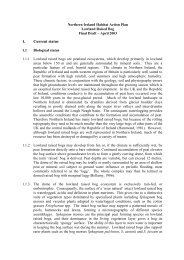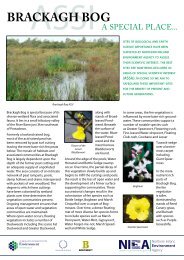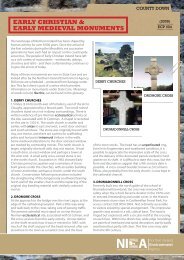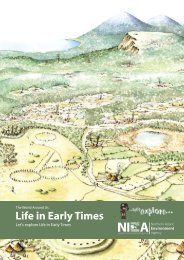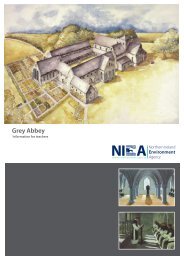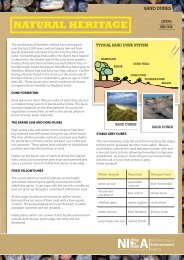Binevenagh Nature Reserve Information for Teachers (.PDF 0.97
Binevenagh Nature Reserve Information for Teachers (.PDF 0.97
Binevenagh Nature Reserve Information for Teachers (.PDF 0.97
You also want an ePaper? Increase the reach of your titles
YUMPU automatically turns print PDFs into web optimized ePapers that Google loves.
<strong>Binevenagh</strong> <strong>Nature</strong> <strong>Reserve</strong><br />
The Walk<br />
Visits to the reserve can be arranged with NIEA staff at<br />
North West <strong>Nature</strong> <strong>Reserve</strong>s or Roe Valley Country Park.<br />
The best approach to the reserve is from the car park<br />
of St Aidan’s Church, grid reference: 673314. The walk<br />
is approximately 4 km. It begins with a steep ascent,<br />
starting at 50 m above sea level and climbing steeply to<br />
nearly 200 m above sea level in just 1 km. A narrow path<br />
leads up through the woods until you reach the reserve.<br />
Continue climbing until you come to the edge of the<br />
cliffs. Make your way eastwards across the reserve using<br />
the various stiles. You will eventually pass through a<br />
small steep valley. You leave the reserve and move on to<br />
a <strong>for</strong>estry road. From here you will be able to make your<br />
way back to the car park at St Aidan’s.<br />
3<br />
Geology and Geomorphology<br />
www.ni-environment.gov.uk<br />
Part of the reason why <strong>Binevenagh</strong> is designated as a<br />
reserve is because of its geology and geomorphology.<br />
Geology means the study of rocks. Geomorphology<br />
deals with the way our landscape has changed over<br />
time. <strong>Binevenagh</strong> contains many examples of the<br />
<strong>for</strong>ces that have shaped our landscape: volcanoes,<br />
glaciers, weather and the influence of man. The most<br />
obvious feature of the site is the basalt cliffs, which<br />
rise majestically above it. These were <strong>for</strong>med some<br />
55 million years ago, at the same time as the Giant’s<br />
Causeway. The basalt was <strong>for</strong>med as thick lava gradually<br />
cooled in a series of flows. These can clearly be seen as<br />
distinct bands in the rock.<br />
Another feature of the cliffs is the huge areas of slippage<br />
at the western end of the cliffs. These were <strong>for</strong>med as<br />
a result of the action of ice. During the last Ice Age a<br />
glacier moving from west to east undercut the softer<br />
clays and chalk, which are the more ancient rocks<br />
laying below the basalt. When the ice melted 12,000<br />
years ago there would have been nothing to support<br />
the rock and it slumped down to its present position.<br />
To understand the process it might be instructive to<br />
think of a river undercutting its banks leading to the<br />
collapse of the bank above. In between the sheer basalt<br />
cliffs and the grassy slope is an area of large boulders.<br />
These rocks have fallen from the cliff over time. This is a<br />
normal feature of steep cliffs and is known as the scree<br />
slope. It is caused by the action of ice expanding and<br />
contracting on the steep rock face, known as freezethaw<br />
weathering. It is the same process that cracks<br />
pipes in cold weather.







